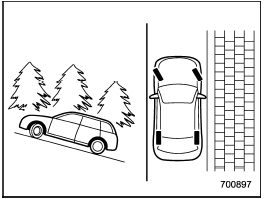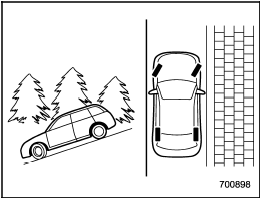Parking tips
When parking your vehicle, always perform the following procedure.
- Apply the parking brake firmly.
- For MT models, put the shift lever in the “1” (1st) position when on an upgrade or the “R” (Reverse) position when on a downgrade.
- For AT models, put the select lever in the “P” (Park) position.
- When parking on a hill, always turn the steering wheel as follows.

When the vehicle is facing uphill, the front wheels should be turned away from the curb.

When the vehicle is facing downhill, the front wheels should be turned into the curb.

- Never leave unattended children or pets in the vehicle. They could accidentally injure themselves or others through inadvertent operation of the vehicle. Also, on hot or sunny days, the temperature in a closed vehicle could quickly become high enough to cause severe or possibly fatal injuries to people.
- Do not park the vehicle over flammable materials such as dry grass, waste paper or rags, as they may burn easily if they come near hot engine or exhaust system parts.
- Be sure to stop the engine if you take a nap in the vehicle. If engine exhaust gas enters the passenger compartment, occupants in the vehicle could die from carbon monoxide (CO) contained in the exhaust gas.

- Always set the parking brake firmly when parking your vehicle.
Never rely on the transmission alone to hold the vehicle.
- If your vehicle has a front underspoiler and rear underspoiler (if equipped), pay attention to blocks and other obstructions on the ground when parking.
The underspoilers could be damaged by contact with them.
See also:
Operating the driver’s window (type B)
Operating the driver’s window (type B)
1) Open
2) Automatically open
3) Close
To open:
Push the switch down lightly and hold it.
The window will open as long as the
switch is held.
This s ...
Bi-level heating
This setting allows you to direct air of different temperatures from the instrument
panel and foot outlets. The air from the foot outlets is slightly warmer than from
the instrument panel outlets. ...
Rear combination lights
1. Using a Phillips screwdriver, remove
the upper and lower screws that secure
the rear combination light assembly.
2. Slide the rear combination light assembly
rearward and remove it from ...


